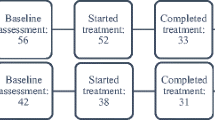Abstract
Acceptance approaches, which have been receiving increased attention within behavior therapy, seek to undermine the linkage between private events and overt behavior, rather than attempting to control the form or frequency of private events per se. Research comparing control versus acceptance strategies is limited. The present study examined the behavioral and subjective impact of a control-based versus acceptance rationale, using a cold pressor task. Subjects in the acceptance group demonstrated greater tolerance of pain compared to the control-based and placebo groups. Only the control-based rationale targeted the subjective experience of pain but it did not differ across rationales. Results confirmed that acceptance was effective in manipulating the believability of reason giving, a key process measure. By encouraging individuals to distance themselves from their private events, acceptance methods may help reduce the use of emotional reasons to explain behavior and hence shift concern from moderating thoughts and feelings to experiencing the consequences of one’s action. Acceptance is a promising new technique. Its effect is all the more surprising given that it teaches principles (e.g., “thoughts do not cause behavior”) that run counter both to the popular culture and to the dominant approaches within empirical clinical intervention.
Similar content being viewed by others
References
ARNTZ, A., & SCHMIDT, A. J. (1989). Perceived control and the experience of pain. In Andrew Steptoe & Ad Appels (Eds.), Stress, personal control and health (pp. 131–162). Brussels-Luxembourg: Wiley.
BARLOW, D. H., & CRASKE, M. G. (1989). Mastery of your anxiety and panic. New York: Graywind Publishing Company.
BERNSTEIN, D. A., & BORKOVEC, T. D. (1973). Progressive relaxation training. Champaign, IL: Research Press.
BIGLAN, A. (1990). A contextual approach to treating family distress. In G. Singer & L. Irvin (Eds.), Supporting the family: Enabling a positive adjustment to children with disabilities. Baltimore: Paul H. Brookes.
CORDOVA, J., & KOHLENBERG, R. (1994). Acceptance and the therapeutic relationship. In S. C. Hayes, N. S. Jacobson, V. M. Follette, & M. J. Dougher (Eds.), Acceptance and change: Content and context in psycholotherapy. Reno, NV: Context Press.
DOUGHER, M. J., & HACKBERT, L. (1994). A behavior-analytic account of depression and a case report using acceptance-based procedures. Special Section: Clinical behavior analysis. Behavior Analyst, 17, 321–334.
FLOR, H., & TURK, D. C. (1988). Rheumatoid arthritis and back pain: Predicting pain and disability from cognitive variables. Journal of Behavioral Medicine, 11, 251–265.
GEISER, D. (1992). A comparison of acceptance-focused and control-focused interventions in a chronic pain treatment center. Unpublished doctoral dissertation. University of Nevada, Reno.
GREENBERG, L. S. (1994). Acceptance in experiential therapy. In S. C. Hayes, N. S. Jacobson, V. M. Follette, & M. J. Dougher (Eds.), Acceptance and change: Content and context in psychotherapy. Reno, NV: Context Press.
HAYES, S. C., AFARI, N., McCURRY, S. M., & WILSON, K. G. (1990). The efficacy of Comprehensive Distancing in the treatment of agoraphobia. Paper presented at the meeting of the Association for Behavior Analysis, Nashville, TN.
HAYES, S. C., JACOBSON, N. S., FOLLETTE, V. M., & DOUGHER, M. J. (1994). Acceptance and change: Content and context in psychotherapy. Reno, NV: Context Press.
HAYES, S. C., WILSON, K. G., GIFFORD, E. V., FOLLETTE, V. M., et al. (1996). Experiential avoidance and behavioral disorders: A functional dimensional approach to diagnosis and treatment. Journal of Consulting and Clinical Psychology, 64, 1152–1168.
HINES, E. A., & BROWN, G. E. (1932). A standard stimulus for measuring vasomotor reactions: Its application to the study of hypertension. Proceedings of the Staff Meetings of the Mayo Clinic, 7, 332.
HOLROYD, K. A., & ANDRASIK, F. (1978). Coping and the self-control of chronic tension headache. Journal of Consulting and Clinical Psychology, 46, 1036–1045.
JACOBSON, N. S. (1992). Behavioral couple therapy: A new beginning. Behavior Therapy, 23, 493–506.
JACOBSON, N. S., & CHRISTENSEN, A. (1996). Integrative couple therapy: Promoting acceptance and change. New York: Norton.
KABAT-ZINN, J. (1991). Full catastrophe living: Using the wisdom of your body and mind to face stress, pain, and illness. New York: Delta.
KOENER, K., JACOBSON, N. S., & CHRISTENSEN, A. (1994). Emotional acceptance in integrative behavioral couple therapy. In S. C. Hayes, N. S. Jacobson, V. M. Follette, & M. J. Dougher (Eds.), Acceptance and change: Content and context in psychotherapy. Reno, NV: Context Press.
LETHEM, J., SLADE, P. D., TROUP, J. D., & BENTLEY, G. (1983). Outline of a fear-avoidance model of exaggerated pain perception I. Behaviour Research Therapy, 21, 401–408.
LINEHAN, M. (1994). Acceptance and change: The central dialectic in psychotherapy. In S. C. Hayes, N. S. Jacobson, V. M. Follette, & M. J. Dougher (Eds.), Acceptance and change: Content and context in psychotherapy. Reno, NV: Context Press.
MARLATT, G. A. (1994). Addiction and acceptance. In S. C. Hayes, N. S. Jacobson, V. M. Follette, & M. J. Dougher (Eds.), Acceptance and change: Content and context in psychotherapy. Reno, NV: Context Press.
MELZACK, R., & WALL, P. (1965). Pain mechanisms: A new theory. Science, 150, 971–978.
PHILIPS, H. C. (1987). The psychological management of chronic pain: A treatment manual. New York: Springer Publishing Company.
SCHWARTZ, G. E., DAVIDSON, R. J., & GOLEMAN, D. J. (1978). Patterning of cognitive and somatic processes in the self-regulation of anxiety: Effects of meditation versus exercise. Psychosomatic Medicine, 40, 321–328.
SHEARIN, E. N., & LINEHAN, M. M. (1992). Patient-therapist ratings and relationship to progress in dialectical behavior therapy for borderline personality disorder. Behavior Therapy, 23, 730–741.
SHUMATE, M., & WORTHINGTON, E. L., Jr. (1987). Effectiveness of components of self-verbalization training for control of cold pressor pain. Journal of Psychosomatic Research, 31, 301–310.
SLADE, P. D., TROUP, J. D., LETHEM, J., & BENTLEY, G. (1983). The fear-avoidance model of exaggerated pain perception II. Behaviour Therapy Research, 21, 409–416.
SPIELBERGER, C. D., GORSUCH, R. L., & LUSHENE, R. E. (1970). Manual for the State-Trait Anxiety Inventory (Self-Evaluation Questionnaire). Palo Alto, CA: Consulting Psychologists Press.
STERNBACH, R. A. (1987). Mastering pain: A 12-step program for coping with chronic pain. New York: G. P. Putman.
TAN, S.-Y. (1980). Acute pain in a clinical setting: Effects of cognitive-behavioral skills training. Unpublished doctoral dissertation, McGill University.
TAN, S.-Y., & POSER, E. G. (1982). Acute pain in a clinical setting: Effects of cognitive-behavioural skills training. Behaviour Research Therapy, 20, 535–545.
TURK, D. C. (1978). A coping skills-training approach for the control of experimentally produced pain. Dissertation-Abstracts-International; 39(4-B), 1972.
TURK, D. C., MEICHENBAUM, D., & GENEST, M. (1983). Pain and behavioral medicine. New York: Guilford Press.
WEGNER, D. M., SCHNEIDER, D. J., CARTER, S. R., III, & WHITE, T. L. (1987). Paradoxical effects of thought suppression. Journal of Personality and Social Psychology, 53, 5–13.
ZETTLE, R. D., & RAINS, J. C. (1989). Group cognitive and contextual therapies in treatment of depression. Journal of Clinical Psychology, 45, 436–445.
Author information
Authors and Affiliations
Additional information
Preparation of this manuscript was supported in part by a grant from the National Institute of Health, National Institute on Drug, Abuse, Grant Number DA08634.
Rights and permissions
About this article
Cite this article
Hayes, S.C., Bissett, R.T., Korn, Z. et al. The Impact of Acceptance Versus Control Rationales on Pain Tolerance. Psychol Rec 49, 33–47 (1999). https://doi.org/10.1007/BF03395305
Published:
Issue Date:
DOI: https://doi.org/10.1007/BF03395305




